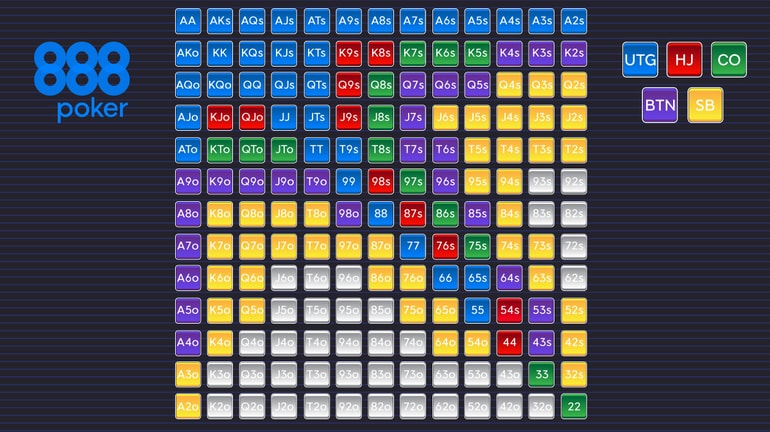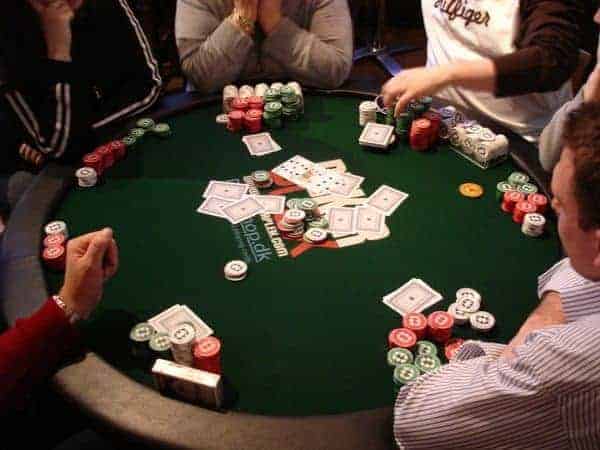Poker Starting Stack Calculator
- Poker Starting Stack Calculator Cheat
- Poker Starting Stack Calculator Excel
- Poker Starting Stack Calculator For Dummies
- Poker Starting Stack Calculator Formula
Stack size plays a very important role in the game of no limit Texas Hold'em. At any point during the game there is the possibility that all of your chips can be put on the line, so it is important that your are not only aware of your own stack size, but the size of your opponents' stacks also.
The amount of chips in front of you and the amount in front of the players around you influence a number of aspects of play in Texas Hold'em, ranging from the psychological to the mathematical.
This article aims to address the key points that you should remember with regards to understanding stack sizes in poker.
Poker stack sizes guide.

The size of a player's stack is always in relation to the blinds of that particular game. A $2000 chip stack may sound like a lot on its own, but if they blinds are $100/$200 then this is a very small amount to be playing with in no limit Hold'em. The following table should give you an idea of what is considered to be small, medium and big stack sizes:
Tip 2: Be Stack Size Aware. Effective stack size plays a critical role in a tournament players success. Having a deep stack, and therefore expanding an opening range to include a lot of speculative suited hands and small pairs is a tournament strategy that is going to be punished if a number of short stacks are yet to act behind. Starting Hand Selection: Chen Formula: Sklansky Starting Hand Groups. The Chen formula is a system for scoring different starting hands in Texas Hold’em. It was created by Bill Chen for use in the book Hold’em Excellence by Lou Krieger. Bill Chen is also the guy that wrote The Mathematics of Poker. Tournament Setup & Starting Stack Distributions Tournaments are actually a fairly recent invention that has grown immensely in popularity since Chris Moneymaker won the World Series of Poker in 2003. Now, it’s the most common poker format played in home games. Cash games - For cash games, you will typically only need either 2 or 3 different chip values - and the chip values will be equal to the stakes value. For example, in a $1/$2 game, you will only need $1 and $5 chips for the bets, and you will want a third chip value for the $0.50 small blind. A good rule of thumb is that the big blind should be about 1-2% of the starting stack size at the beginning of a tournament. This means that a tournament with a starting stack of T2,000 should have starting blinds at 10/20 at least and 25/50 at most.
- Small: 40 big blinds or less.
- Medium: 41 – 90 big blinds.
- Big: 91 big blinds or more.
- Deep: 200 big blinds or more.
A diagram to show the general difference between small, medium, big and deep-sized stacks in NL Hold'em.
Most online and live poker rooms have limits on how much or how little you can bring to the table from the start. There is typically a 10BB minimum and a 100BB maximum for the majority of limits. This means that players have the option of buying in as a small, medium or big stack from the off. As you can see there is also a 'deep stack' condition if you have 200 big blinds or more.
This is common in cash games if a player has bought in for the maximum amount (usually 100BBs) and has either doubled up through an all-in confrontation against another player of equal stack size, or has managed to grind there way up into the realm of the 'deep stack'.
How stack sizes affect the way you play.
The size of your stack in poker affects the way that you actually play your cards. If you have a short stack then it will be difficult or impossible to make elaborate bluffs or plays because of the simple fact that you don't have enough chips to scare opponents away from their hands.
On the other hand, if you have a large amount of chips in front of you then it is possible to make more advanced plays because you have more chips to work with to manipulate your opponent into thinking that you have a better hand than them. Therefore it is more advantageous to play simple ABC poker with short stacks: betting your strong hands and folding your weak hands.
If you are short stacked, you want to play big cards that have the best chances of winning in an all-in situation early on in the hand.
The effect of stack sizes on implied odds.
Another important fact of stack sizes is the implied odds (and potential reverse implied odds) that are made available by having a big stack. If you and your opponent have a big stack, then your implied odds increase when you have drawing hands.
For example if you know that your opponent raises 3.5BBs with AA and will be prepared to go all in on the flop with an overpair, it makes it a profitable decision to call with a hand like 78 because of the amount you can expect to win when you hit the flop hard.
It is for the same reason why it is profitable to call raises with small pocket pairs to try and hit a set, even though the chance of hitting a set is usually far less than the odds you are getting. So if you are up against big stacks it can be profitable to open up your starting hand requirements to include suited connectors and so on, whereas if you are up against short stacks you should stick with the big starting hands.
Psychology and stack sizes.
Psychological aspects are also involved with stack sizes in poker. If you have a big stack and you are up against an opponent with an equally big stack, then there is the possibility that you could lose all your chips in this one particular hand.
Alternatively, if you are up against an opponent that has a small stack, it is not possible for you to lose more than the amount your opponent has in front of them. This means that players will have a greater concern when playing against big stacks than when playing against small stacks.
Poker players are more wary about how they play their hand when up against an equally big stack.
Stack size psychology example.
Lets say there is a raise from player A in late position and player B with Q J calls on the button, everyone else folds. There are now two players going to a flop and they both have big stacks of around 100BBs each, and player A's hand is unknown.
Poker Starting Stack Calculator Cheat
The flop comes 2 J 7, giving player B top pair. Player A is first to act and bets the size of the pot.
This actually puts player B in a difficult situation because even though they hold top pair with a decent kicker, player A is showing a lot of strength. Player B decides to call because a re-raise will commit a large number of chips into the pot with only top pair.
The turn comes 5, which probably did not help either player.
Player A bets the size of the pot again, and player B quickly decides to fold because they are not prepared to commit so much money into the hand with a hand like top pair.

Stack sizes example evaluation.
Player A in this example may have had a better hand or he may have been totally bluffing, but it is not the focus of this example. In this hand player A was showing a lot of strength and forcing player B to make difficult decisions.
These decisions were made even more difficult due to the fact that player A was making it aware that they were willing to put a large amount of chips on the line in this hand. Therefore player B made the decision to fold the hand because there was too much of a risk of putting a big number of their chips into the pot with a marginal holding like top pair.
However, if player A only had 20BBs or 30BBs, then it is more likely that player A would have called the raises or moved player A all-in because there are less chips at stake. The point being made from this example is that it is easier to get big stacks off marginal hands because the prospect of having to call large bets and put more money on the line influences the way that an opponent will play their hand.
The bigger your stack, the less likely it is for an opponent to put up a fight with a marginal hand like top pair. This is especially true if you continue to bet strongly on the turn after betting the flop.
Poker stack size strategy evaluation.
It is fair to say that a large number of poker players do not factor in stack sizes (more specifically, effective stack sizes) when making decisions at the poker table. You should always try and consider the future implications of any hand depending on the size of your stack and the size of your opponents stack. Ask yourself if you really want to get into a big pot with a marginal holding against another big stack.
You should also consider whether it's worth calling the bet on the flop if you are fairly confident that you are going to fold when you opponent bets again on the turn. There are many sub-factors involved in stack sizes that it requires some experience to fully understand the implications of each situation.

It takes practice to get to grips with it, so get out there and play some hands!
Tip: To get good with stack sizes, experiment by playing tournaments (SNGs and MTTs) and cash games that are either short (40bb) or deep stacked (200bb). Don't limit yourself to 100bb poker. Develop your ability to play optimally versus a variety of stack sizes.
Go back to the awesome Texas Hold'em Strategy.
Comments
Starting Hand Selection: Chen Formula : Sklansky Starting Hand Groups
The Chen formula is a system for scoring different starting hands in Texas Hold’em. It was created by Bill Chen for use in the book Hold’em Excellence by Lou Krieger. Bill Chen is also the guy that wrote The Mathematics of Poker.
The process looks a little tricky at first, but it’s really quite straightforward and logical after you have worked through a handful of examples.

The Chen formula.
- Score your highest card only. Do not add any points for your lower card.
- A = 10 points.
- K = 8 points.
- Q = 7 points.
- J = 6 points.
- 10 to 2 = 1/2 of card value. (e.g. a 6 would be worth 3 points)
- Multiply pairs by 2 of one card’s value. However, minimum score for a pair is 5.
- (e.g. KK = 16 points, 77 = 7 points, 22 = 5 points)
- Add 2 points if cards are suited.
- Subtract points if their is a gap between the two cards.
- No gap = -0 points.
- 1 card gap = -1 points.
- 2 card gap = -2 points.
- 3 card gap = -4 points.
- 4 card gap or more = -5 points. (Aces are high this step, so hands like A2, A3 etc. have a 4+ gap.)
- Add 1 point if there is a 0 or 1 card gap and both cards are lower than a Q.(e.g. JT, 75, 32 etc, this bonus point does not apply to pocket pairs)
- Round half point scores up.(e.g. 7.5 rounds up to 8)
For step 5, it’s easier to refer to this extra 1 point as a 'straight bonus' to save confusion between steps 4 and 5. Subtracting 1 point for 1 gap and then adding it back again for lower cards seems a bit awkward I know, but that’s the way it works.
Chen Formula calculator.
Chen formula hand example scores.
- A K
- A = +10 points.
- Suited = +2 points.
- Final score = 12 points.
- T T
- T = 10 x 1/2 = +5 points.
- Pair = multiply by 2.
- Final score = 10 points.
- 5 7
- 7 = 7 x 1/2 = +3.5 points.
- Suited = +2 points.
- 1 card gap = -1 point.
- 0 - 1 card gap, both cards under Q = +1 point.
- Final score = 6 points. (5.5 points rounded up)
- 2 7
- 7 = 7 x 1/2 = +3.5 points.
- 4+ card gap = -5 points.
- Final score = -1 point. (-1.5 points rounded up)
- A A
- A = +10 points.
- Pair = multiply by 2.
- Final score = 20 points.
So now we know how to work out how many points different hands are worth, what can we do with the numbers to help us with starting hand selection?
Using Chen formula hand points.
The main reason behind using the Chen formula for different starting hands was so that you can categorize them based on the Sklansky and Malmuth hand groups table.
That’s all well and good for helping you to compare the strength of different starting hand in Hold’em, but it doesn’t really do much in the way of strategy for starting hand selection. Therefore, I have done a little bit of work and created a starting hand strategy using the Chen formula.
Chen formula starting hand strategy.
- Only ever consider calling a raise with 10 points or more.
- Always raise or reraise with 12 points or more.
Short-handed strategy. (6 players)
Early position.
- Raise = 9 points or more.
- Fold = 8 points or less.
Mid position.
- Raise = 8 points or more.
- Fold = 7 points or less.
Late position.
- Raise = 7 points or more.
- Fold = 6 points or less.
Full-ring strategy. (10 players)
Early position.
- Raise = 10 points or more.
- Fold = 9 points or less.
Mid position.
Poker Starting Stack Calculator Excel
- Raise = 9 points or more.
- Fold = 8 points or less.
Late position.
- Raise = 7 points or more.
- Fold = 6 points or less.
'Raise' = Raise if there have been no raises or calls before you.
'Fold' = Fold regardless if there has been a raise before you or not. Just fold.
About my Chen formula starting hand strategy.
As with any set of rules or guidelines in poker, this Chen formula starting hand strategy isn’t perfect and will have it’s flaws. However, I like to think that this is an easy-to-use and solid preflop strategy using the Chen formula.
Most of the strategy involves either raising or folding preflop, which is a solid approach to take as a new player and a style that you will grow accustomed to as your game progresses. The starting hand requirements are also a little tight, but that’s only to be expected if you’re using a guide and you haven’t quite found your feet when it comes to starting hand selection yet.
I took inspiration from the Chen formula article at SimplyHoldem.com (no longer active) to create this starting hand strategy. I decided to develop my own because I believe that the guidelines at Simply Holdem were flawed because:
- It does not distinguish between short and full ring games.
- Just calling the big blind is not a profitable way to play NL Hold’em for the most part.
Poker Starting Stack Calculator For Dummies
Chen formula evaluation.
The Chen formula is never going to be a complete substitute for proper preflop starting hand strategy. It will also take a little getting used to if you want to work hand scores out on the fly. However, this is as good a formula as you are going to find for working out preflop starting hand strengths in NL Hold’em.
The starting hand strategy I worked out will also have its own flaws, but again this is as good as a simple guideline is going to get for those preflop decisions.
Poker Starting Stack Calculator Formula
Go back to the awesome Texas Hold'em Strategy.
Comments